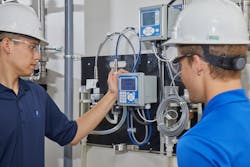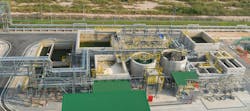Applying process analytical technologies in the chemical processing industry
The ability of different industries to learn from each other and advance in parallel helps all companies involved. This has been the case in recent years as the pharmaceutical and chemical processing industries have both benefitted from the application of process analytical technologies (PAT), supported by sophisticated analyzers, used to control manufacturing processes.
The underlying concept suggests that with the right analyzer technologies, applied so they can read inline, it is possible to monitor a process while it is happening, and to optimize critical parameters using this information. This contrasts with simply testing a product in a lab when it is finished to see if it has the correct attributes or is off-spec.
Monitoring production in this way calls for a variety of analyzer types, designed to look for those parameters able to indicate ideal conditions. Many of these relate to liquid analysis, but applications do not stop there, particularly since many technologies can now be installed inline to provide real-time measurements, as opposed to past requirements for lab analysis.
Production, but safety too
Most of the applications for PAT relate to production, which we will discuss in a moment, but analyzer technologies also perform critical safety functions. For example, for boiler and fired heaters — often associated with reactors and distillation processes — combustion control is critical. If a process is running lean in oxygen, there will be some carbon monoxide formed. If the process is running rich in oxygen, formation of NOx occurs, which ends up as nitric and nitrous acid in the atmosphere. Rosemount OCX8800 Combustion Probes, for example, continuously measure carbon monoxide (CO) and oxygen (O2) in flue ducts to ensure balanced air-to-fuel mixtures. This supports efficient fuel consumption without excessive CO or NOx compounds as effluents.
Depending on the size of a facility, there can be many such installations supporting a variety of applications. Flue duct walls, as well as the combustion probes themselves, can become hot enough to ignite combustibles, so it is critical to ensure such conditions do not develop. Consequently, boiler operators establish controls around the measurement of CO and O2 concentration because fuel-to-air imbalances can cause the unit to shut down. Reliability and accuracy in this application is necessary to avoid a problem escalating, but also to prevent false trips, since shutting down a boiler or fired heater can shut down the process it supports.
Monitoring liquid characteristics
One of the main elements of PAT in the chemical industry is its use to monitor a process so it can be optimized while the process can still be adjusted, rather than sticking with fixed parameters throughout a long production run. Since there may not be a sensor to quantify a specific attribute of the process — such as verifying that a reaction is complete by monitoring the concentration of a product — common generic measurements must serve as indicators. These often include conductivity, pH and dissolved oxygen.
Conductivity — Measuring liquid conductivity is a useful way to quantify the presence of conductive ions in a solution, which may also be used to determine total dissolved solids. Within chemical processing industries, conductivity measurements can be used to determine the acidity or alkalinity of a solution. For example, Emerson’s Rosemount 242 Flow-Through Toroidal Conductivity Sensor is a frequent choice to verify sulfuric acid concentrations during concentrated (93-98%) sulfuric acid production, produced for use as a feedstock for fertilizer and dye production.
Chemical processing plants use separator units to separate organic phases from aqueous phases, and toroidal sensors are often used for interface detection between the two. Monitoring total dissolved solids is also critical for boiler feedwater and cooling tower water (Figure 1) to avoid deposits on critical surfaces. Since hydrogen ions and chloride ions are corrosive to metals, monitoring also helps prevent corrosion of turbine blades, heat exchangers and pipes.
pH — The presence of surplus hydrogen ions in a solution makes it acidic, whereas bases accept hydrogen ions. This is reflected via the common pH scale of 1 to 14, and measurement of this characteristic is critical in a variety of applications, including everything from fermentation processes to treated wastewater.
For one example, in ethanol production during the conversion of corn starch and the subsequent fermentation phase, the pH must be maintained within a tight range. This requires careful monitoring because enzymes and microbes breaking down starches and metabolizing glucose during this phase requires specific conditions for greatest yield and efficiency. If not adjusted, fermentation may take a long time to reach the optimal range, adding extra cost and time.
In heavier chemical processing applications, the Rosemount RBI pH/ORP Sensor is a premium pH sensor for use in oil refining to determine the presence of sulfides in feedstocks capable of poisoning catalysts, or sour water effluent. These tough pH sensors are also used extensively in the chlor-alkali process for pH control at critical steps.
These sensors can be used in combination with the Rosemount 56 Dual Channel Liquid Analysis Transmitter (Figure 2), with features such as data logging and charting to help operators identify and understand recent process performance and events. Advanced diagnostics, such as glass and reference impedance information, also help users understand when pH sensors are nearing the end of their useful life.
Dissolved oxygen — These sensors are frequently associated with their common application of measuring aeration basins in wastewater treatment processes (Figure 3), but they are also used in other areas, such as oxygen control in fermentation tanks when producing ethanol for gasoline blending. Emerson’s Rosemount 499ADO, for example, uses a membrane covered amperometric sensor to measure dissolved oxygen between 0 and 20 ppm.
Using data
Analyzers alone are not a solution, because plant personnel must make use of the data they provide. One of the ways companies like Emerson are making data easier to use and more readily actionable is by giving users clear information about what the numbers mean. For example, the Rosemount 56 Dual Channel Transmitter allows users to access troubleshooting guidance or simple technical explanations about any number or alert with the push of a button. The transmitter also allows users to directly download process data so they can analyze it in their preferred tool.
The dominant method used with PAT is time series analysis, which follows trends. Rosemount liquid and combustion transmitters can send measurement and diagnostic information over a 4-20 mA with HART® or digital fieldbus signal to a programmable logic controller (PLC) or distributed control system (DCS) in real time. At the PLC/DCS end, users can analyze the data for trends and make predictions.
Accurate and reliable liquid analysis measurements, following PAT concepts, are critical in a wide range of chemical processing facilities to protect capital assets, ensure product quality, increase process uptime and reduce energy costs. These measurements are now more widely available in real-time due to advances in online analyzers, allowing chemical plants to close control loops quickly, instead of relying on outdated data from lab instruments.
Charu Pandey is a senior technical support specialist with Emerson’s Analytical division, specializing in liquid and combustion applications. Charu holds a bachelor’s degree in Chemical Engineering from University of Florida, and a PhD in Chemical Engineering from Georgia Institute of Technology.
About the Author
Charu Pandey
Senior technical support specialist with Emerson’s Analytical division
Charu Pandey is a senior technical support specialist with Emerson’s Analytical division, specializing in liquid and combustion applications. Charu holds a bachelor’s degree in Chemical Engineering from University of Florida, and a PhD in Chemical Engineering from Georgia Institute of Technology.


